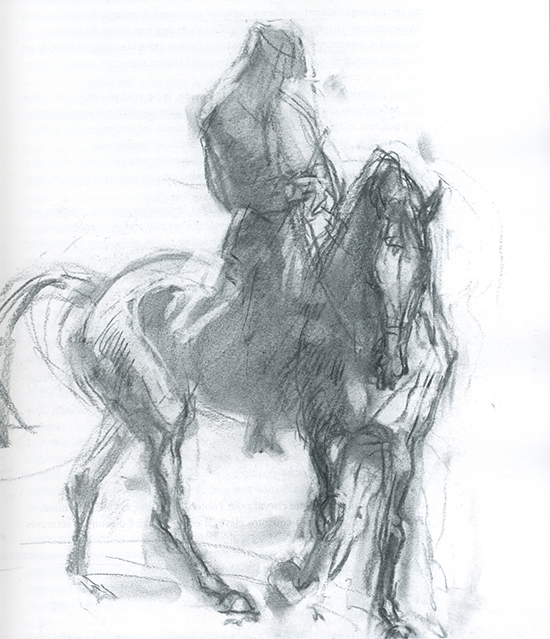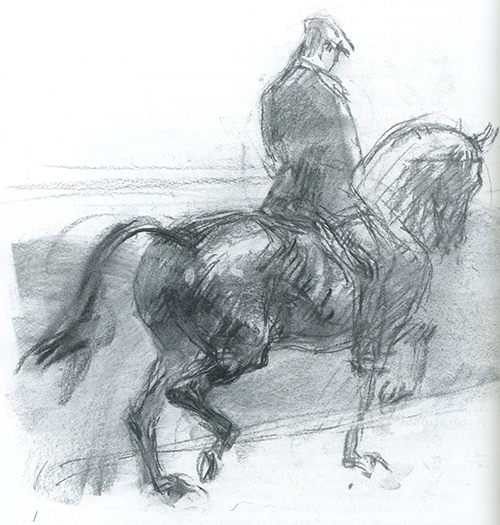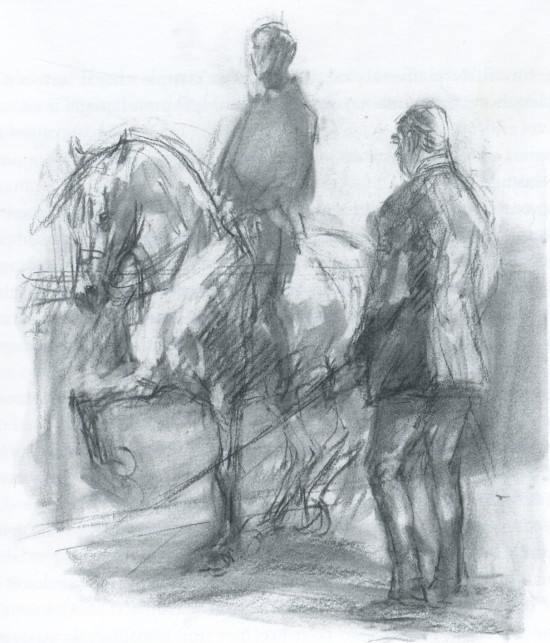We have the horse doing the shoulder-in correctly,
and we are now ready to do more advanced work in order to achieve more collection…
In all the work we have done, our horse has been bent around the inside leg and moving in the opposite direction of his bend. Now he is going to be bent around the inside leg and he is going to move in the direction of his bend.
I start again at walk by doing a small circle around the inside leg in the shoulder-in position. When I feel the horse round, supple, forward and on the bit, I stop the action of my inside leg (it stays in the same place on ‘stand by’) and I increase the action of my outside leg in order to bring his hindquarters in.
If he stops, I push him energetically forward and if he loses the bend, I return to the small circle around the inside leg to achieve the bend again. When he understands what I am asking and he obeys by doing one or two steps with the hindquarters in, I reward with a pat and make him move forward.
I ask only a few steps at a time, alternating between the hindquarters in and the turn around the inside leg. When the horse is responding well, I ask more frequently and later I increase the number of steps with the hindquarters in. When confirmed in this work, I can make a full circle, I can make the circle smaller and I can gradually decrease the circle to finish with the pirouette at the walk.
This work introduces the horse to the first lateral movement looking in the direction in which he is moving and now he is ready to start this kind of work at the trot.
All this work enables the horse to collect the trot, when we proceed on in lateral work, from shoulder-in inclusive, the work is executed in collected trot.
On a 20 metre circle after asking for some transitions from collected trot to medium trot and back to collected trot to ensure that the horse has impulsion and is obedient to the half halt with a firm but soft contact (the correct contact is the result of the correct balance and impulsion) I put my horse in the shoulder-in position. When I feel him well bent around my inside leg, I increase the action of my outside leg to bring his quarters in. When he obeys, I reward with a pat, I rise and lengthen the trot while maintaining the circle.
Again I remember the old saying ‘ask often, expect little and reward generously’. I ask only for a few strides at each time, when the horse responds well, I begin asking more frequently and later on, I can increase the number of strides with the hindquarters in. This is the technique I am going to use in all the lateral work that is to follow.
It is very important to be accurate in the geometrical shape of the circle and maintaining the correct and the same rhythm. If the horse loses the bend I bring him back to the shoulder-in position to recover the bend, once the bend is re-established, I start to ask the hindquarters in again.
The advantage of starting this work on a circle is being able to correct and start again at any time. Suppose we start by teaching the half pass and at the end of the diagonal the horse loses the bend, I can’t correct straight away I have to go back and begin the whole movement again. If I am on the circle and I lose the bend, I can immediately start the hindquarters in again. I can also do it more often without increasing the number of strides when the horse is still learning the exercise. If I increase the number of strides at the beginning, the horse can find it difficult and begin resisting and trying to find an easier and incorrect way. By repeating the exercise more often, at the end I have done the same amount of work without letting the horse find the work too difficult.
When the horse is comfortable in this work and I can do a full circle with the hindquarters in, I can start the training of the half pass, travers and renvers. Normally I start first with the half pass, but we can start with the travers – in any case, the half pass is nothing more than a variation of the travers.
To teach the half pass at the middle of the short wall I put the horse in shoulder-in position, I cross the corner in that position and at the beginning of the long wall, I increase the action of my outside leg and I start the half pass. After a few strides, I reward, and I make my horse move forward, straight and parallel to the long wall. If I lost the bend during the half pass, I put him in shoulder-in position again. I always use the shoulder-in to re-establish the bend.
To teach the travers, I do the same on the short wall, but I don’t cross the corner, I start the travers when the horse’s shoulders reach the beginning of the long wall. When the horse is established in this work, I will not have any problems training the renvers, which is the inverse movement in relation to the travers, and I have my horse doing the more important gymnastic exercises he needs to develop and increase the collection at this stage of training.
Use of the wall will influence differently the travers and the renvers. On the travers, the wall will reinforce the psychological and physical effect of the half halt, because the horse’s instinct tells him that he cannot go through the wall. With the renvers, the wall will control the inside hind leg making it easier for the rider to keep the horse’s hind leg underneath his body.
Also at this stage I should have started the lateral work at the canter, but this work will be dealt with in a future article. I am now going to explain some transitions and combinations of exercises that I use to further develop collection and to improve the quality of the piaffe and passage later on.
The first exercise is the transition from the shoulder-in on the straight to the hindquarters-in on the circle, from the hindquarters-in to the medium trot while maintaining the circle and collecting again by returning to the shoulder-in. It is important to keep the rhythm especially in the hindquarters-in and not allow the hindquarters come in too much, because if so, he will lose the fluency of the trot.
Another exercise I use to develop suppleness and collection is transitions from shoulder-in to travers and back to shoulder-in. Again the maintenance of the rhythm is one of the proofs of the maintenance of correct balance and impulsion. I have to pay special attention to the control of the inside leg of the weaker side of the horse when doing travers to this side. If he escapes and brings the hindquarters in too much, I must correct by bringing him back to shoulder-in.
I make transitions from this shoulder-in in trot, to walk in shoulder-in, to increase the engagement action of my half halt, which passes through better in this balance. Also from the shoulder-in I make transitions to medium trot on the circle taking advantage of the suppleness, engagement and impulsion developed by the transitions, shoulder-in – travers.
The next exercise I use normally is the transition, travers-renvers-travers-renvers etc. I make transitions to walk in renvers, and from this renvers, I make the horse straight, I halt, and rein back, and depart in trot again. I only do the smallest number of steps at the walk, only the ones I need to do to straighten the horse up and to halt straight and square. I find this exercise extremely useful to develop the piaffe and passage.
To develop the piaffe activity after a few transitions travers-renvers, I make the horse straight and ask for piaffe.
To develop the piaffe engagement, I make the transitions travers-rein back -piaffe.
To develop the passage, I make some transitions, travers-renvers and from renvers, when I feel good collection and impulsion, I take the passage.
One other example of the use of the exercises, is the situation where the horse is lazy with one leg, say the right leg, while performing passage. I make transitions from trot in hindquarters in on a circle to the right, to passage, and back to the trot putting the hindquarters in, if I feel the right hind leg lazy again.
There are many different transitions and combinations of exercises we can use in the training. The ones that I have spoken about are only the basic ones that I have found good to use as examples. There is not such a thing as a catalogue that sets out a precise combination of exercises that you can find in a book, and follow to the letter to train your horse. Every rider and trainer should use his or her imagination and choose which exercises the horse needs to develop any particular basics or quality – it is a question of common sense, knowledge and experience.
At the beginning of this article, I said that the correct contact is the result of correct balance and impulsion. Contact has always been the cause of arguments, misconceptions and misinterpretations: contact is a result of a combination of qualities, contact does not make anything happen, what makes things happen is that combination of qualities. If I try to get the contact directly by an opposing resistance with my hands to the pushing of my legs, probably I will end up having some sort of contact, but I don’t believe this kind of contact will produce anything useful. I think because of this, we find so many riders complaining that their horses are too strong, this is no doubt a very modern and kinder way of says that the horse is heavy, unbalanced and contracted.
We also find riders who have abandoned their horse, without contact and any kind of impulsion and engagement, long and on the forehand – with the rider thinking that their horse is light.
Lightness to me is the perfect obedience of the horse to the rider’s aids, where the slightest possible use of the aids, gets the maximum possible response from the horse.
To produce this we have to have contact, but a contact that is the result of the correct balance and impulsion. This correct balance and impulsion, also gives us self carriage.
The illustrations are by Jean Louis Savart



